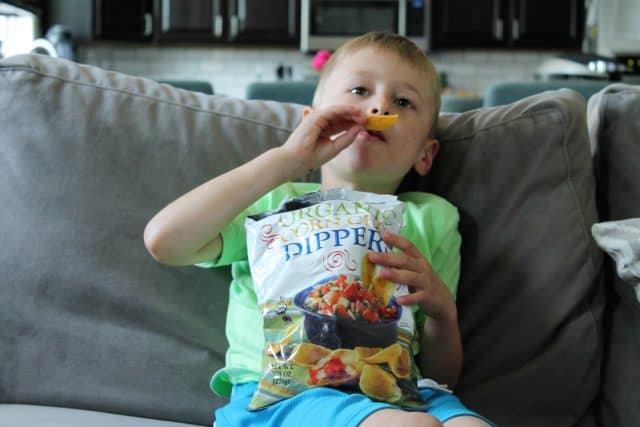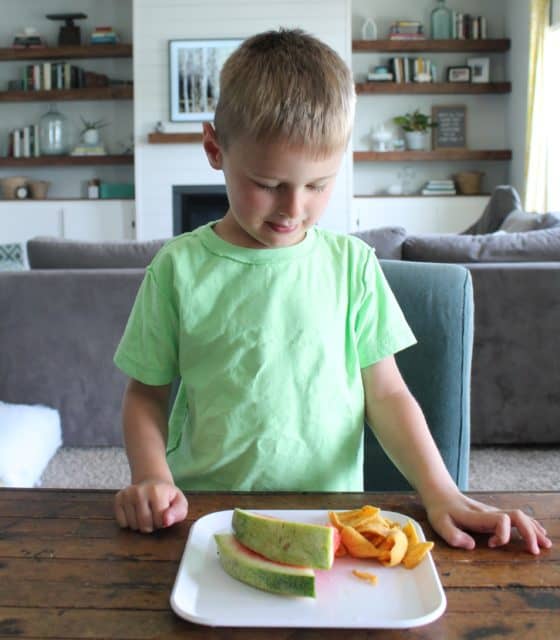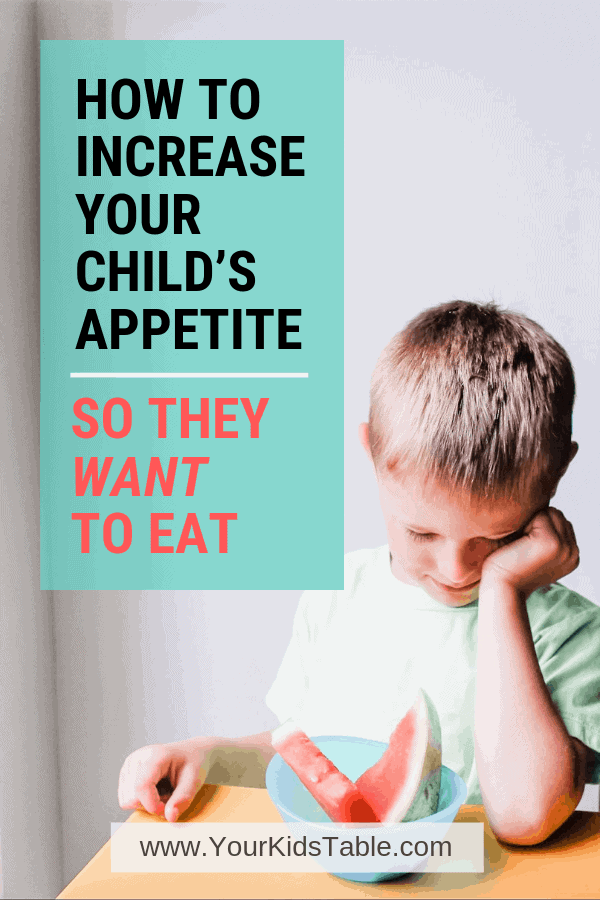Want to know how to increase appetite in a child? Find out 5 different tips to help your child want to eat so that you can enjoy meals and end that stressful worry!
She took a deep breath before she yelled, “It’s time for dinner!” She knew what the response would be, and right on cue about 3 seconds later, her daughter yelled back, “I’m not hungry,” as she flitted through the kitchen pushing her baby in the toy stroller.
The problem is her daughter NEVER seems to be hungry. It doesn’t matter if it’s breakfast, lunch, or dinner, she doesn’t want to sit and if she does, she barely eats anything.
This little girl, Grace, doesn’t get angry or upset about food, she just doesn’t have an appetite. And, no matter how hard her mother tries to entice her with foods that other kids love, Grace isn’t interested.
If you have a child like Grace at home, you know how stressful it is as you worry about calories, weight, and growth. But, there are ways to give your child’s appetite a boost and help them start to want to eat when you ring the dinner bell.
Why Do Some Kid’s Have a Poor Appetite
First, it’s important to understand why some kids seem to not want to eat. And, while there’s some overlap here with picky eating, having a poor appetite can be it’s own animal. Some kids aren’t really picky, they just aren’t hungry.
It seems unnatural and it’s not as common, but a non-existent appetite does happen for a reason. Let’s talk about some of those reasons:
1. Sometimes it’s not a problem with appetite at all. On the surface, it might seem like our kids don’t want to eat, but underneath, it’s really all about a difficulty with eating. When kids are sensitive to textures (see more in sensory issues with food) or have trouble chewing foods (aka oral motor skills), then eating is hard and painful. That sets off a child’s adrenaline and as it rushes through the body, their appetite shuts off.
This is also why it’s critical to make sure mealtimes are as positive of an experience as possible. And, why avoiding bribing, begging, or rewarding can also backfire (Read more in the best picky eating tip).
2. Poor appetite can be caused by snacking, of all things. Kids will only eat enough to keep their hunger signals turned off and if they have access to food or milk throughout the day, they may never get truly hungry. And, kids that snack or graze all day may never learn to listen to those signals, so even if frequent snacking stops in the future, it can take some time for the connection between hunger and eating to be made.

3. If both of the above causes are ruled out, then I consider if a child is silently suffering with acid reflux, food allergies, or some other type of digestive issue. Many kids, toddlers, and babies don’t know what normal digestion feels like, they may not complain or cry because of the pain, but they do know that eating will make it worse. And, that means that they’ll just keep on refusing to eat.
It’s also possible that the brain isn’t even sending any hunger signals because when you’re not feeling well, you don’t feel any hunger. This is the body’s way of protecting itself.
4. Lastly, some children don’t seem to sense that they’re hungry. That signal that most of us get from our stomach to our brain that seems to say: “Hey, feed me,” isn’t getting through. Some therapists consider this the 8th sense, and its called interoception.
Interoception is our sense that controls all of our automatic responses like when we’re hungry, when we’re full, when we need to go to the bathroom, etc. It’s the bodily functions that we sort of take for granted, but sometimes that communication simply isn’t happening.
What About an Appetite Stimulant for Kids?
Most doctors and pediatrician’s will only be concerned about your child’s appetite if they aren’t growing or putting on weight well. If they aren’t, often the first step is feeding therapy. And, the next step is trying a prescribed pharmaceutical appetite stimulant. In my experience, the one most commonly given is Periactin.
While I’ve only worked with a limited group of kiddos using Periactin (generic name is Cyprheptadine) or another appetite stimulant, I’ve not seen consistent results. For some kids, it has helped a little, but I’ve seen a lot of families trying to cope with the side effects. You can find a list of those side effects here.
I say that not to sway you, but to simply inform you of all the different aspects of choosing this route.

How to Increase Appetite in a Child (5 Simple Tips)
Sometimes the situation is desperate, and if a child doesn’t start eating, they may be placed on a feeding tube. That’s a scary thing for a family to face, and trying a drug first could very well be worth it. But, if there’s time, and usually there is, I like to start with some other strategies:
- Schedule – First and foremost, because this can change everything. I suggest making sure you’re feeding your child only at meals and scheduled snacks. I schedule those meals based on an interval of every 2 and 1/2 to 3 hours apart. That means if your child starts eating breakfast at 8 am that they start their next meal at 10:30 to 11 am. And, that continues throughout the day.
One of the biggest misconceptions I see is that when a child is eating poorly you should let them eat wherever and whenever they want because anything is better than nothing. I get it, that seems to make sense, but remember how we talked about kids eating just enough to take the edge off their appetite.
Well, 2 goldfish cracker here and a pretzel there can absolutely tank a child’s appetite. Over and over again, I’ve seen parents make this one change with eating on a schedule and huge changes happen in how much food their child is willing and able to eat!
- Water – It’s also important to give your child water in between meals so they don’t fill up on milk or juice because both of those beverages can also top off an appetite. And, when a child doesn’t particularly enjoy eating or they’re a busy toddler, they’d rather just drink those calories. Instead, pair milk or juice with their meals or immediately afterwards.
- Get moving – Running, jumping, and any other type of physical activity can help increase your child’s appetite. Sedentary activities, especially watching a tablet, phone, or TV for long periods of time burn few calories and your child may not be as hungry as a result.

- Mindfulness – Remember how some kids don’t seem to notice that they’re hungry? Well, talking to them about if their belly feels full or empty is a great way to start making that connection! Ask questions like, “How does your belly feel, empty or full?” And, be prepared for them not to be sure, if you know they haven’t eaten for a while, you want to tell them that it’s empty!
Next week, I’ll have an entire new post dedicated to mindfulness activities so you can grab some more ideas. To make sure you don’t miss it, I have this free printable: 9 Ways to Improve Your Child’s Eating. I’ll send it to your inbox and let you know when that new post is ready!
- Explore – Many kids with a decreased appetite haven’t had a lot of positive experiences with food, or even interacted with it very much. That’s why giving them an opportunity to play with and explore food is beneficial. It may light an interest in eating that wasn’t there before, and at a minimum, it can help them get used to new and different foods.
To encourage exploration, think about setting up cooking activities for your child to help with. Sensory bins are also great way to use cooked noodles, dry rice, and other foods in play. Even making painted prints and art with different types of food. Like, what type of shape does the noodle make or can you use broccoli as a paintbrush?
Many kids will benefit from a combination or all of these activities to increase their appetite! Make sure you’re keeping the doctor in the loop and that you’re consistently trying, which can sometimes be the hardest part!
How to Increase Baby Appetite
I wanted to talk briefly about baby appetite here, because some of the strategies above won’t work for babies. For instance, they are on their own unique schedule, depending on how old they are. (You can find a 6 month old feeding schedule and an 8 month old feeding schedule to help).
Also, milk is their primary source of nutrition up until age 1, but it’s important that babies are eating table foods by 10-11 months old. (Head to How to Transition to Table Foods if you need help with that.)
Most commonly, when I see babies not wanting their milk, it’s due to acid reflux, sometimes silent reflux. This can be hard to diagnose, but it happens a lot. You can read this post on how to help babies with silent reflux to learn more about the symptoms, so that you’re able to talk to your doctor and together choose the best course of treatment.
Food allergies, such as dairy and soy, are another common culprit.
Beyond that, once a baby is 6 months old, you can focus on serving them foods at 1-2 meals per day. Pick a time in your routine, eat together, and stick to it day in and day out so they know what to expect. You may want to schedule food time before bottle or nursing if it’s only real food that they’re refusing or showing no interest in.
During meals, bring in that exploration time by letting them spread baby food all over their tray, even if the won’t put it into their mouth. Think about playing with food too, away from the table, and encouraging them to chew on teething toys so they get practice.
Help for Kid’s That Aren’t Eating Well
If you have a child that you believe is also a picky eater and you want to get some powerful tips from an occupational therapist, then join me in my free workshop: 3 Keys to Turn Around Picky Eating.
These keys are helpful for building your child’s appetite and I’ll also send you a free workbook to use in your email!
Click here to get a spot in the free workshop!
Also Check Out More for Kid’s with Poor Appetites:
Why Getting Sick Can Snowball Into Picky Eating
A Weird but Effective Trick for Picky Eaters
Perfect Lunch Ideas for Picky Eaters at School, Home, or Daycare
Alisha Grogan is a licensed occupational therapist and founder of Your Kid’s Table. She has over 14 years experience with expertise in sensory processing and feeding development in babies, toddlers, and children. Alisha also has 3 boys of her own at home. Learn more about her here.

My gd almost 4 won’t eat anything else but toast with peanut paste or Nutella on it. If we don’t give her that she refuses anything else. Likes her water and helps herself to that. She is thin and anaemic. On iron atm but will probably need an iron infusion
My just turned 4 yr old gd won’t eat anything but toast with either peanut paste or Nutella on it. She is extremely anaemic. We are tearing our hair out. If she doesn’t get that she won’t eat
Hi Linda, have you taken our free picky eating webinar? You can sign up and take at your own convenience here.
Best,
Laura
Your Kid’s Table team member
I have a seven years old who has very poor appetite and some problems with texture. She has not grown much and we have seen an endocrinologist recently and we are waiting for the test results. I am very worried and I don’t know what else I can try to help her grow. What do you recommend? I am willing to try everything. Thank you!
Hi Victoria, if texture is an issue for eating, check out ways to work on her oral sensory processing. Depending on what she eats, we also have a few weight gain articles that might help.
Best,
Laura
Your Kid’s Table team members
Hi doctor , my 2.5 years old daughter is very moody to eat main meals , but most of the time she has enough appetite to eat junk foods like cakes , ice cream , chocolate , potato chips and … . she usually has the schedule of eating junk foods for 2 days and then have a good appetite to eat full meals on third day and this repeats again . What do you recommend to improve her eating habits ?
Hi Fati! Try implementing a snack/meal schedule, where she eats every 2-3hrs (breakfast, snack, lunch, snack, dinner). In between those 2-3hrs, only offer water. This may help improve her appetite at mealtime and make her actually want to eat what is being served. We have a blog post with more tips for limiting junk food, here!
Best,
Kalyn
Any advice for a toddler (turning 2 next week) who actually seems to like most foods but constantly needs “new” foods to actually eat? My daughter will like a food and eat it well once, maybe twice before she gets bored and won’t eat it(except for most fruit–she will almost always eat fruit well)? She seems to have a very low appetite and seems to get “bored” with food and will skip entire meals (even with items that she’s eaten well previously). I’m not sure if it’s just that she has low appetite and is waiting for a food that strikes her fancy for the day or if there is something else going on. She does drink milk well but only drinks about 8-12 oz a day and just a small amount of water. I avoid juice but sometimes let her have homemade popsicles before bed (we always do a bedtime snack). I have been feeding her snacks/meals about every 2-2.5 hrs.
Hey Sherilyn,
I know how frustrating this can be!! I’d still use the tips in the article and try to stretch the feedings to 2.5/3 hours. Make sure the milk is only offered during the meals and that water is in between (this will definatly help if you are having something else in between). Also, take a look at this food list for Toddler Meals. I’d try to only have a food once a week and then have the same food next week, but in a different presentation such as size, shape, etc.
Best,
Desiree
Hello, I have 20 months old daughter, who have problem with feeding. Ever since she turned 9 months. She presented to hungry but refused every meal. Offered vitamins but no improvement. As she grows old she seemed have appetite but no time to eat. What should I do? she lost her weight now.
Hi Aman,
Have you done our picky eating workshop yet? What foods does she currently eat? We have a toddler based course as well, but start there and we can point you toward a better fitting resource if need be.
Best,
Laura
Your Kid’s Table team member
My four year old is a super picky eater, mostly to do with having low muscle tone which makes chewing a real chore and having some sensory issues. We always have trouble getting him to eat. And he never seems to be hungry. But two weeks ago we enrolled him in a kids cooking class. All of the sudden he is coming home from class with funny food concoctions and asking to eat things like tomatoes and mayonnaise!! And he wants to help in the kitchen! I love all your suggestions and I think this list will help us keep him on a roll! Thank you for posting!!
Oh that’s fantastic!! I love cooking as a strategy! So glad it was helpful:)
Wow – that sounds like my son. He’ll be 4 in March and I’m exhausted trying to get him to eat.
Hey Sara,
We understand! Hopefully this article helped you with some tips!
Best,
Desiree
Hello Alisha !
my son (will be 6 in September) was a poor eater but all the 5 tips you write are enough I believe to change course. A great deal of the success lies on us moms (and dads also): we must not push kid to eat or get nervous about it, the feel it and do the opposite. Now we talk together – I mean with my son – and I trust him that one he will taste for the first time yogurt. He started by hating even to smell it, now he stands me eating it and in the future (he says in 2-3 years from you) he says he will try it. So, trust your kid and help them !
That’s great Theodora, that’s such a good outlook to have, it will help your son eat more!